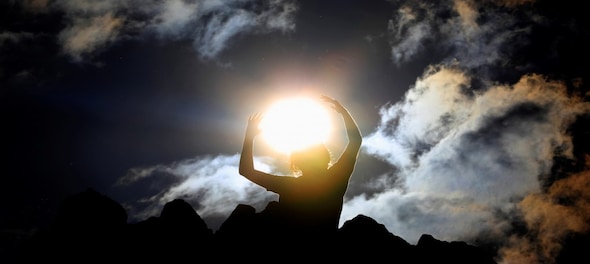
This year, stargazers will get a special treat on the occasion of the summer solstice, which falls on June 21. The significant celestial event with the Sun reaching its highest point in the Northern Hemisphere will also see the planets Venus and Mars aligning with a slender crescent moon in the evening twilight.
The three celestial bodies will make a captivating appearance in the western sky from June 19 to June 22.
To add more to the delight of astronomers, the Da Vinci glow or the Earthshine, will also be visible. The Earthshine occurs when sunlight is reflected by the Earth onto the dark side of the waxing crescent moon.
Observers in North and South America won't get to witness such an event until March 28, 2028, reports said.
When to watch
On June 20, the crescent moon will join bright Venus and dim Mars to form a striking alignment in the western twilight sky. The moon will be nearly 8 percent illuminated, with the Da Vinci glow visible on its darkened portion, according to LiveScience.
The most captivating view will occur on June 21, after the onset of the Summer Solstice. According to Timeanddate.com, a right-angle triangle will form between Mars, Venus, and the crescent moon which will be illuminated by up to 13 percent.
The recurring Da Vinci glow is set to capture the viewer’s attention.
On June 22, the moon will be illuminated up to 21 percent as it will once again align with Mars and Venus, but this time it will be positioned above the pair of planets. It will be near Regulus, a star in the constellation Leo.
How to watch
The event can be witnessed with the naked eye but on June 21, viewers may need binoculars or a small telescope as spotting the relatively dim Mars may prove challenging.
On other days too, the celestial phenomena can be observed with the naked eye, but binoculars or a telescope will provide a mesmerising close-up view of the Da Vinci glow.
The Summer Solstice marks a significant event for different groups and cultures, and arguably the most famous event happens at Stonehenge in the UK.
During the Summer Solstice, an ancient stone circle marks the position of the rising Sun at the solstices presenting a remarkable use of architecture. Though, it is not clear if it was built to do so as the history of the structure is shrouded with mysteries.
(Edited by : Sudarsanan Mani)
First Published: Jun 20, 2023 2:40 PM IST
Check out our in-depth Market Coverage, Business News & get real-time Stock Market Updates on CNBC-TV18. Also, Watch our channels CNBC-TV18, CNBC Awaaz and CNBC Bajar Live on-the-go!


PM Modi visits Ram Mandir for first time since 'Pran Pratishtha', offers prayers before roadshow
May 5, 2024 8:59 PM
Visiting temples, obliging selfie requests, jabbing rivals – Kangana Ranaut is wooing voters on campaign trail
May 5, 2024 8:23 PM

